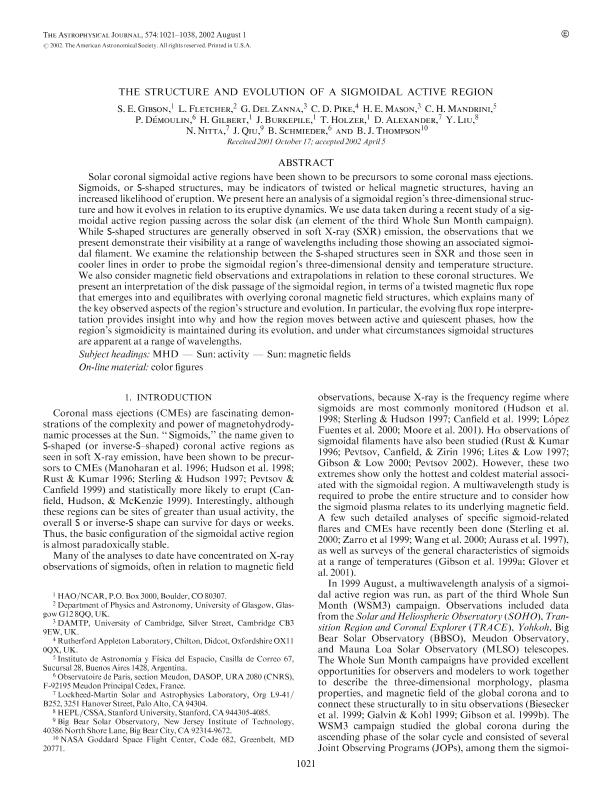Artículo
The Structure and Evolution of a Sigmoidal Active Region
Gibson, S. E.; Fletcher, L.; Del Zanna, G.; Pike, C. D.; Mason, H. E.; Mandrini, Cristina Hemilse ; Démoulin, Pascal; Gilbert, H.; Burkepile, J.; Holzer,T.; Alexander, D.; Liu, Y.; Nitta, N.; Qiu, J.; Schmieder, B.; Thompson, B.
; Démoulin, Pascal; Gilbert, H.; Burkepile, J.; Holzer,T.; Alexander, D.; Liu, Y.; Nitta, N.; Qiu, J.; Schmieder, B.; Thompson, B.
 ; Démoulin, Pascal; Gilbert, H.; Burkepile, J.; Holzer,T.; Alexander, D.; Liu, Y.; Nitta, N.; Qiu, J.; Schmieder, B.; Thompson, B.
; Démoulin, Pascal; Gilbert, H.; Burkepile, J.; Holzer,T.; Alexander, D.; Liu, Y.; Nitta, N.; Qiu, J.; Schmieder, B.; Thompson, B.
Fecha de publicación:
08/2002
Editorial:
IOP Publishing
Revista:
Astrophysical Journal
ISSN:
0004-637X
Idioma:
Inglés
Tipo de recurso:
Artículo publicado
Clasificación temática:
Resumen
Solar coronal sigmoidal active regions have been shown to be precursors to some coronal mass ejections. Sigmoids, or S-shaped structures, may be indicators of twisted or helical magnetic structures, having an increased likelihood of eruption. We present here an analysis of a sigmoidal region´s three-dimensional structure and how it evolves in relation to its eruptive dynamics. We use data taken during a recent study of a sigmoidal active region passing across the solar disk (an element of the third Whole Sun Month campaign). While S-shaped structures are generally observed in soft X-ray (SXR) emission, the observations that we present demonstrate their visibility at a range of wavelengths including those showing an associated sigmoidal filament. We examine the relationship between the S-shaped structures seen in SXR and those seen in cooler lines in order to probe the sigmoidal region´s three-dimensional density and temperature structure. We also consider magnetic field observations and extrapolations in relation to these coronal structures. We present an interpretation of the disk passage of the sigmoidal region, in terms of a twisted magnetic flux rope that emerges into and equilibrates with overlying coronal magnetic field structures, which explains many of the key observed aspects of the region´s structure and evolution. In particular, the evolving flux rope interpretation provides insight into why and how the region moves between active and quiescent phases, how the region´s sigmoidicity is maintained during its evolution, and under what circumstances sigmoidal structures are apparent at a range of wavelengths.
Palabras clave:
Magnetohydrodynamics
,
Solar Activity
,
Solar Magnetic Fields
Archivos asociados
Licencia
Identificadores
Colecciones
Articulos(IAFE)
Articulos de INST.DE ASTRONOMIA Y FISICA DEL ESPACIO(I)
Articulos de INST.DE ASTRONOMIA Y FISICA DEL ESPACIO(I)
Citación
Gibson, S. E.; Fletcher, L.; Del Zanna, G.; Pike, C. D.; Mason, H. E.; et al.; The Structure and Evolution of a Sigmoidal Active Region; IOP Publishing; Astrophysical Journal; 574; 2; 8-2002; 1021-1038
Compartir
Altmétricas



